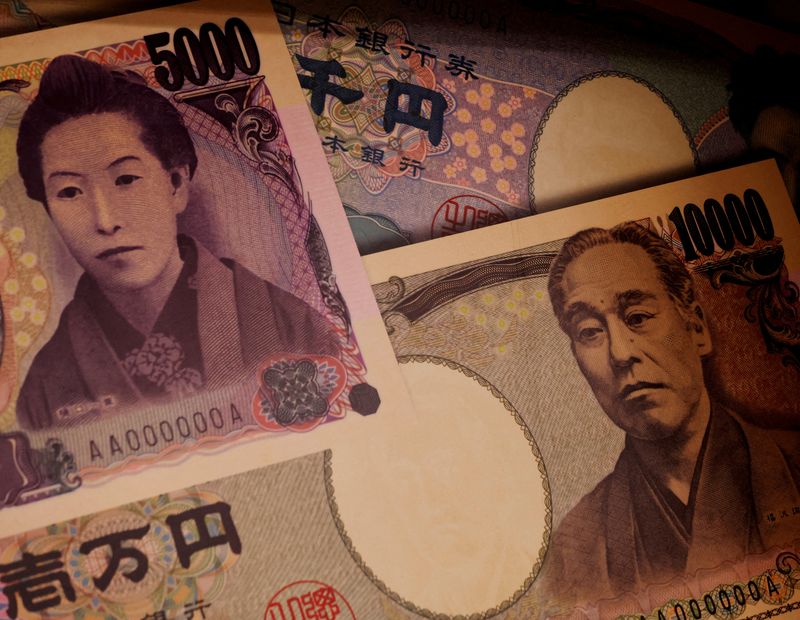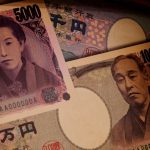LONDON/SINGAPORE (Reuters) -The yen headed for its strongest week in nearly three months on Friday as traders unwound long-held bets against the currency ahead of crucial U.S. inflation data that could help cement expectations for where Federal Reserve rates might head.
The yen has dominated the currency markets this month, surging to a near three-month high of 151.945 per dollar on Thursday after starting the month at a 38-year low of 161.96 per dollar.
On Friday, the yen was last at 154.245 to the dollar, which was set for a 2.5% loss for the week, its biggest weekly decline against the Japanese currency since late April-early May, as a sell-off in global stocks drove investors into safe havens, including the yen.
The rally follows suspected interventions by Tokyo in early July that wrong-footed traders and led to an unwinding of profitable carry trades, in which traders borrow the yen at low rates to invest in dollar-priced assets for higher returns.
“I think the speed of the yen rally means we are probably due some consolidation pretty soon,” said James Athey, fixed income portfolio manager at Marlborough Investment Management.
“But ultimately with the shine coming off risk assets and data and Fedspeak suggesting cuts are coming, I still feel the yen has further to appreciate.”
The Swiss franc, another carry-trade funding currency, has also benefitted. It has pushed the dollar down by 0.9% this week to reach its strongest in over four months.
It was last 0.2% weaker on the day at 0.8834 francs.
Investor attention on Friday will focus on U.S. personal consumption expenditure data, the Federal Reserve’s favoured measure of inflation. The PCE data is expected to come in at 0.1% on a monthly basis.
The Fed meets next week and is expected to hold borrowing costs steady this time but markets are fully pricing in a rate cut in September. Traders also anticipate 66 basis points of easing this year.
The Bank of Japan, on the other hand, may raise rates next week, with markets pricing in a 64% chance of a 10 bps hike.
The surge in the yen, though, may allow the central bank to take its time, though some analysts believe the rate element is only one side of the story.
The other is a consistent outflow of cash from Japanese markets, both from domestic and foreign investors, according to BofA currency strategist Kamal Sharma.
“What you’re seeing is Japanese investors and foreign investors leaving the Japanese market and investing in global tech, predominantly. So unless whatever the BOJ does persuades (investors) to come back into the Japanese asset market, it’s very hard to make the case that the yen is in the midst of a turning point for now,” he said.
The dollar index, which measures the U.S. currency versus six others, was little changed at 104.29. The euro was a tad stronger at $1.08575.
The dollar found its footing after data on Thursday showed the U.S. economy expanded faster than expected and inflation slowed in the second quarter.
“The U.S. economy has not run out of steam just yet, despite having restrictive interest rates for quite some time,” said Kristina Clifton, a senior economist at Commonwealth Bank of Australia (OTC:CMWAY).
Clifton anticipates the first rate cut will come in November. “We expect that the FOMC will require a long string of lower inflation readings before easing interest rates.”
Sterling was 0.12% higher at $1.2865 but well below the one-year high of $1.3044 hit last week, with traders pricing a 50% chance of the Bank of England cutting rates next week. Markets are anticipating 51 bps of cuts this year.

The souring risk sentiment this week has weighed heavily on the Australian dollar and the New Zealand dollar, with both currencies – seen as risk proxies – down nearly 2% for the week. [AUD/]
On Friday, both gained some respite, with the Aussie up 0.39% at $0.6564, above Thursday’s near three-month low, while the kiwi rose 0.3% to $0.59.
To read the full article, Click Here

